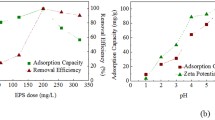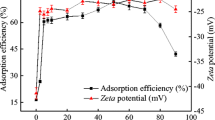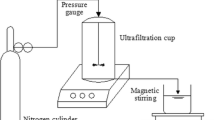Abstract
Extracellular polymeric substances (EPS) were extracted from Aspergillus fumigatus using cationic exchange resin technique. The EPS were mainly composed of polysaccharide and low quantities of protein and nucleic acid. Biosorption of Cd(II), Pb(II), and Cu(II) of EPS was investigated as a function of pH using differential pulse polarography and the Ruzic model. Results showed that the EPS biosorption capacity determined using either the direct titration curves i = f(C M) or the method proposed by Ruzic (Analytica Chimica Acta 140:99–113, 1982) were coincident. Cu(II) had the highest affinity with EPS followed by Pb(II) and Cd(II). The total number of binding sites for Cu(II) and Cd(II) increased with pH in the range of 4.0–7.0. Similar trend was observed for Pb(II) at pH 4.0–5.0, while precipitates were observed at pH 6.0 and 7.0. The conditional binding constants of these three metals displayed low levels of fluctuation with pH and ranged from 4.02 ± 0.02 to 5.54 ± 0.05.

Similar content being viewed by others
References
Bradford, M. M. (1976). A rapid and sensitive method for the quantification of microgram quantities of protein utilizing the principle of protein-dye binding. Analytical Biochemistry, 72, 248–254.
Burdman, S., Jurkevitch, E., Soria-Diaz, M. E., Serrano, A. M. G., & Okon, Y. (2000). Extracellular polysaccharide composition of Azospirillum brasilense and its relation with cell aggregation. FEMS Microbiology Letters, 18, 259–2649.
Cheng, W., & Hu, Y. Y. (2004). Adsorptive decolorization of azo dyes by Aspergillus pellets HX. Chinese Journal of Applied Environmental Biology, 10(4), 489–492.
Comte, S., Guibaud, G., & Baudu, M. (2008). Biosorption properties of extracellular polymeric substances (EPS) towards Cd, Cu and Pb for different pH values. Journal of Hazardous Materials, 151, 185–193.
Esparza-Soto, M., & Westerhoff, P. (2003). Biosorption of humic and fulvic acids to live activated sludge biomass. Water Research, 37, 2301–2310.
Frolund, B., Palmgren, R., Keiding, K., & Nielsen, P. (1996). Extraction of extracellular polymers from activated sludge using a cation ion exchange resin. Water Research, 30, 1749–1758.
Gerhardt, P., Murray, R. G. E., Wood, W. A., & Krieg, N. R. (1994). Methods for general and molecular bacteriology. Washington: American Society for Microbiology. Chapter 5.
Guibaud, G., Tixier, N., Bouju, A., & Baudu, M. (2004). Use of a polarographic method to determine copper, nickel and zinc constants of complexation by extracellular polymers extracted from activated sludge. Process Biochemistry, 39, 833–839.
Jahn, A., & Nielsen, P. H. (1995). Extraction of extracellular polymeric substances (EPS) from biofilms using a cation exchange resin. Water Science and Technology, 32, 157–164.
Lau, T. C., Wu, X. A., Chua, H., Qian, P. Y., & Wong, P. K. (2005). Effect of exopolysaccharides on the adsorption of metal ions by Pseudomonas sp. CU-1. Water Science and Technology, 52, 63–68.
Ledin, M. (2000). Accumulation of metals by microorganisms—processes and importance for soil systems. Earth-Science Reviews, 51, 1–31.
Liu, H., & Fang, H. H. P. (2002). Characterization of electrostatic binding sites of extracellular polymers by linear programming analysis of titration data. Biotechnology and Bioengineering, 80, 806–811.
Loaec, M., Olier, R., & Guezennec, J. (1997). Uptake of lead, cadmium and zinc by a novel bacterial exopolysaccharide. Water Research, 31, 1171–1179.
Morlay, C., Cromer, M., & Vittori, O. (2000). The removal of Cu(II) and nickel(II) from dilute aqueous solution by a synthetic flocculant: a polarographic study of the complexation with a high molecular weight poly(acrylic acid) for different pH values. Water Research, 34, 455–462.
Morillo, J. A., García-Ribera, R., Quesada, T., Aguilera, M., Ramos-Cormenzana, A., & Monteoliva-Sánchez, M. (2008). Biosorption of heavy metals by the exopolysaccharide produced by Paenibacillus jamilae. World Journal of Microbiology and Biotechnology, 24, 2699–2704.
Ozdemir, G., Ozturk, T., Ceyhan, N., Isler, R., & Cosar, T. (2003). Heavy metal biosorption by biomass of Ochrobactrum anthropi producing exopolysaccharide in activated sludge. Bioresource Technologies, 90, 71–74.
Ruzic, I. (1982). Theoretical aspects of the direct titration of natural waters and its information yield for trace metal speciation. Analytica Chimica Acta, 140, 99–113.
Santamaría, M., Díaz-Marrero, A., Hernández, J., Gutiérrez-Navarro, A. M., & Corzo, J. (2003). Effect of thorium on the growth and capsule morphology of Bradyrhizobium. Environmental Microbiology, 5, 916–924.
Savvaidis, I., Hugues, M., & Poole, R. (2003). Differential pulse polarography: a method for the direct study of biosorption of metal ions by live bacteria from mixed metal solutions. Anton Leeuw Int J G, 84, 99–107.
Schiewer, S., & Volesky, B. (1995). Modelling of the proton-metal ion exchange in biosorption. Environmental Science and Technology, 29, 3049–3058.
Skidmore, W. D., Duggan, E. L., & Gonzales, L. J. (1964). Determination of the total phosphorus content of deoxyribonucleic acids in the presence of ethylene glycol by a hydrolysis method. Analytical Biochemistry, 9, 370–376.
Wingender, J., Neu, T. R., & Flemming, H. C. (1999). Microbial extracellular polymeric substances: characterization, structure, and function. Heidelberg: Springer.
Author information
Authors and Affiliations
Corresponding author
Rights and permissions
About this article
Cite this article
Yin, Y., Hu, Y. & Xiong, F. Biosorption properties of Cd(II), Pb(II), and Cu(II) of extracellular polymeric substances (EPS) extracted from Aspergillus fumigatus and determined by polarographic method. Environ Monit Assess 185, 6713–6718 (2013). https://doi.org/10.1007/s10661-013-3059-9
Received:
Accepted:
Published:
Issue Date:
DOI: https://doi.org/10.1007/s10661-013-3059-9




